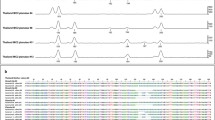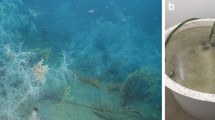Abstract.
Newly settled larvae (primary polyps) or young colonies of the coral Pocillopora damicornis were brought into contact at various periods after planulation to examine isogeneic and allogeneic responses. While young colonies derived from the same colony always fused, those derived from different colonies showed either fusion, nonfusion, or incompatible fusion. Tissues were continuous in incompatibly fused pairs, but a white zone, without zooxanthellae, was observed at the interface. The skeleton was also continuous but a groove with skeletal spines on both sides was observed under the white zone. Polyps originating near the white zone later disappeared or were partially resorbed. After 2–8 months, several incompatibly fused pairs became separated by a skeletal ridge, or by a narrow zone of skeleton without living tissue. Incompatible fusion appears to be a distinct histoincompatible response which later transforms into nonfusion. The period between planulation and initial contact of colonies did not affect the outcomes of the contact experiments.
Similar content being viewed by others
Author information
Authors and Affiliations
Additional information
Accepted: 31 January 1996
Rights and permissions
About this article
Cite this article
Hidaka, M., Yurugi, K., Sunagawa, S. et al. Contact reactions between young colonies of the coral Pocillopora damicornis. Coral Reefs 16, 13–20 (1997). https://doi.org/10.1007/s003380050054
Issue Date:
DOI: https://doi.org/10.1007/s003380050054




